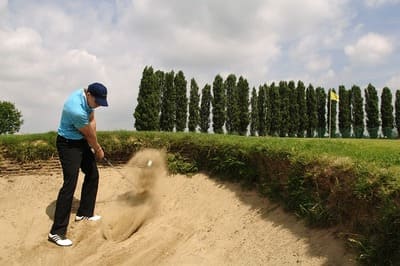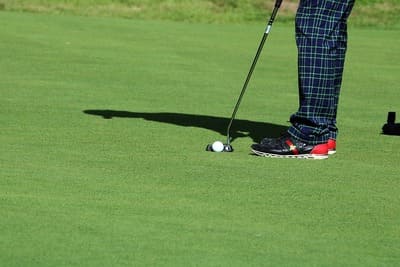Fore! It’s a sunny day on the greens, and you’re standing at the tee, club in hand, ready to take your shot. But as you watch the ball sail through the air, you hear someone shout, “Nice stroke!” And suddenly, you find yourself wondering, “Wait, what is a stroke in golf, anyway?”
If you’ve ever found yourself teeing off into a world of golf jargon and terminology that seems as mysterious as the Bermuda Triangle, fear not. We’ve got your backswing! In this blog post, we’re going to unravel the enigma of the golf “stroke” and break it down into a language that’s more approachable than a friendly caddy.
So, whether you’re a seasoned golfer looking to brush up on your knowledge or a beginner who’s still trying to figure out which end of the club to hold, join us on this golfing adventure as we explore the ins and outs of what a “stroke” really means in the world of golf. Get ready for a hole-in-one explanation that will have you shouting “Fore!” with confidence in no time.
Grab your golf cap, putter, and your sense of curiosity, because we’re about to demystify the elusive “stroke” and make your golfing experience even more enjoyable. Let’s swing into action and dive headfirst into the exciting world of golf terminology. So, what is a stroke in golf? Let’s tee off on this quest for answers!
The Definition of a Stroke in Golf
A stroke in golf refers to the swinging motion made by a golfer to strike the ball. It is the fundamental action that drives the ball towards the target, whether it be the fairway, green, or hole. In simple terms, it is the act of taking a swing with a golf club to make the ball move forward.
It is important to note that a stroke in golf is different from the use of the word in other sports. In golf, a stroke does not indicate a single hit on the ball, but rather the entire sequence of movements that constitute one swing. This includes the setup, backswing, downswing, and follow-through. Each of these elements contributes to the power, accuracy, and consistency of the stroke.
Understanding the Scoring System in Golf
In order to fully grasp the intricacies of golf, it is crucial to have a solid understanding of the scoring system. Unlike other sports where the objective is to score as many points as possible, golf operates on a different principle. The goal in golf is to complete each hole in as few strokes as possible. Each stroke is counted, and at the end of a round, the total number of strokes becomes the score. The player with the lowest score emerges as the winner. Players will keep track of each round on their scorecard.
One key aspect of golf scoring is the concept of par. Par refers to the predetermined number of strokes that an expert golfer is expected to complete a hole or a course in. Typically, par for a hole falls between three and five strokes, depending on its length and difficulty. When a golfer completes a hole in the exact number of strokes defined as par, it is called making a par.
However, if a golfer finishes a hole in one stroke below par, it is known as a birdie. While finishing two strokes below par is called an eagle. Conversely, if a golfer completes a hole in one stroke above par, it is called a bogey, and two strokes above par is referred to as a double bogey. Understanding these terms is essential for interpreting golf scores and appreciating the skill level of the players.

The Role of Strokes in Determining a Golfer’s Score
In the game of golf, strokes play a crucial role in determining a golfer’s score. Each time a golfer takes a swing at the ball, it is counted as a stroke. The number of strokes a golfer takes throughout the course is tallied up to determine their final score. A lower score signifies a better performance, as it means the golfer took fewer strokes to complete the course.
Scoring in golf is based on the principle of “the fewer, the better.” For each hole, there is a predetermined par score, which represents the number of strokes an average golfer is expected to take to complete the hole. If a golfer takes fewer strokes than the par score, they score under par for that hole.
Conversely, if they take more strokes, they score over par. The goal is to achieve the lowest score possible by minimizing the number of strokes taken throughout the entire round. By carefully strategizing their shots and executing precise strokes, golfers aim to achieve a score that reflects their skill and proficiency on the course.
How to Properly Execute a Stroke in Golf
Properly executing a stroke in golf requires a combination of technique, precision, and practice. The first step is to address the golf ball correctly. Position yourself with your feet shoulder-width apart and parallel to the target line. Keep your knees slightly flexed and your weight evenly distributed on the balls of your feet. This stance provides a stable base for your swing and allows for better control and balance throughout the stroke.
As you prepare to swing, focus on maintaining a relaxed grip on the club. A grip that is too tight can restrict the natural movement of your wrists and reduce the fluidity of your stroke. Instead, aim for a light to moderate grip pressure that allows for a smooth and controlled swing.
Additionally, be mindful of your posture and alignment. Keep your back straight, shoulders relaxed, and head down, with your eyes focused on the ball. Align yourself with the target and aim the clubface in the desired direction. Proper posture and alignment set the stage for a solid and accurate stroke.
The Importance of Accuracy and Precision in Golf Strokes
Accuracy and precision are essential aspects of golf strokes that every golfer must strive to master. These two factors play a vital role in determining the overall success of a shot and can significantly impact a golfer’s score. To achieve accuracy in a golf stroke, a golfer must focus on the alignment of their body, club, and target. This involves positioning the feet, shoulders, and hips in the correct direction and maintaining proper balance throughout the swing.
Additionally, precision is crucial in controlling the clubhead’s movements and making contact with the ball at the desired spot. This level of control allows the golfer to achieve consistent results and minimize errors during their shots.
The importance of accuracy and precision in golf strokes cannot be overstated. A slight deviation in alignment or a slight miscalculation in the force applied to the ball can lead to significant deviations in the shot’s direction and distance. Golf is a game of inches, and even the smallest error can have a cascading effect on subsequent shots.
Golfers who focus on cultivating accuracy and precision in their strokes are more likely to consistently hit their targets and avoid costly mistakes. By honing these skills, golfers can increase their chances of achieving lower scores. Which will improve their overall performance on the course.

Different Types of Golf Strokes and Their Purposes
The game of golf involves a wide range of strokes that players can use to navigate the course and achieve their desired outcomes. One common stroke is the drive, which is used to hit the ball as far as possible down the fairway. By employing a powerful and controlled swing, golfers aim to maximize distance while maintaining accuracy. Another essential stroke is the approach, which is used when golfers find themselves near the green but still have a considerable distance to cover. The goal of the approach is to position the ball as close to the hole as possible, setting up the player for a successful putt.
Additionally, golfers utilize the chip shot when they are close to the green but find themselves in a rough or challenging terrain. This stroke requires finesse and accuracy, as the player must execute a controlled and often delicate shot to get the ball onto the green.
Finally, the putt is perhaps one of the most crucial strokes in golf. It is used on the green to roll the ball into the hole. Precision, control, and a keen eye for reading the slope and speed of the green are essential for a successful putt. By mastering these various types of strokes, golfers can enhance their skills and ultimately improve their overall performance on the course.
Common Mistakes to Avoid When Executing Golf Strokes
Many golfers make common mistakes when executing their golf strokes, which can greatly impact their performance on the course. One common mistake is not maintaining a proper grip on the club. The way you hold the club can greatly affect the trajectory and accuracy of your strokes. It is important to have a neutral grip, where the club is held in the fingers and not too tight or too loose. This allows for better control and helps prevent slicing or hooking the ball.
Another common mistake is improper alignment. Alignment refers to how your body and club are set up in relation to the target. If you are not aligned correctly, it can lead to inconsistent shots and missed targets. It is crucial to align your clubface and body parallel to the target line. This ensures that the ball will travel straight towards the intended target. Taking the time to aim correctly before each stroke can make a significant difference in your overall game.
Tips and Techniques for Improving Your Golf Strokes
Golf strokes form the foundation of a golfer’s game, and improving your technique can greatly enhance your overall performance on the course. One key tip for enhancing your golf strokes is to focus on proper grip and hand positioning. The grip plays a crucial role in the execution of a stroke, providing stability and control. Ensure that your grip is neither too tight nor too loose, as both extremes can negatively impact your swing.
Additionally, pay attention to the positioning of your hands on the club. The V formed between your thumb and index finger should be pointing towards your trailing shoulder, promoting a square clubface and enabling a more accurate and powerful stroke.
Another valuable tip for refining your golf strokes involves maintaining a consistent tempo and rhythm throughout your swing. A smooth and well-timed swing can greatly contribute to the accuracy and distance of your shots. To achieve this, focus on maintaining a balanced and controlled swing from the takeaway, through the downswing, and into the follow-through. Practice a deliberate and fluid movement, avoiding any jerky or rushed motions. Developing a consistent tempo will not only improve the fluidity of your strokes but also aid in better timing and clubface control. Which results in more consistent and accurate shots.

How to Practice and Perfect Your Golf Strokes
To practice and perfect your golf strokes, it is essential to prioritize consistency and repetition. Start by selecting a specific stroke that you want to focus on improving. Whether it’s your drive off the tee, your approach shots, or your putting stroke, choose one aspect to concentrate on during your practice sessions. By honing in on a singular stroke, you can dedicate more time and energy towards refining your technique.
Once you have identified the stroke you want to work on, create a structured practice routine that includes a variety of drills and exercises. Begin with warm-up exercises to loosen your muscles and prepare your body for the upcoming practice session. Then, move on to specific drills that target the areas of your stroke that need improvement. For example, if you are struggling with accuracy in your putting, you could set up a series of markers on the green and aim to consistently putt the ball within those markers. The key is to challenge yourself while maintaining a focus on technique and form.
The Role of Mental Focus and Strategy in Golf Strokes
Mental focus and strategy play a crucial role in the execution of golf strokes. In order to achieve a successful stroke, a golfer must maintain a high level of concentration and focus on the task at hand. This requires blocking out distractions and thoughts that might hinder performance. By immersing oneself fully in the present moment and visualizing the desired outcome, a golfer can enhance their mental focus and increase their chances of executing a precise and accurate stroke.
Moreover, strategy is essential in golf strokes as it allows golfers to make calculated decisions based on the layout of the course and the specific challenges they face. Analyzing the terrain, wind direction, and other factors can influence the choice of stroke and its execution.
Additionally, strategic thinking helps golfers determine the best course of action to maximize their advantage. By approaching each stroke with a well-thought-out plan, golfers can increase their chances of achieving optimal results and making proactive choices that enable them to navigate the course successfully.
FAQs
What is a stroke in golf?
A stroke in golf refers to the act of striking the ball with a club with the intention of advancing it towards the hole.
How does the scoring system in golf work?
In golf, each stroke taken to complete a hole is counted. The lower the number of strokes, the better the player’s score. The player with the fewest strokes at the end of the round wins.
How do strokes affect a golfer’s score?
The total number of strokes taken by a golfer throughout the round directly impacts their score. The fewer strokes taken, the lower the score and the better the performance.
What is the proper way to execute a stroke in golf?
To properly execute a stroke in golf, a golfer should align their body, grip the club correctly, take a backswing, and follow through with a controlled and fluid motion to strike the ball.
Why is accuracy and precision important in golf strokes?
Accuracy and precision are crucial in golf strokes because they determine the direction and distance the ball will travel. A slight deviation in aim or power can significantly affect the outcome of a shot.
What are the different types of golf strokes and their purposes?
Different types of golf strokes include drives, putts, chips, pitches, and bunker shots. Each stroke serves a specific purpose and is used in different situations on the golf course.
What are some common mistakes to avoid when executing golf strokes?
Common mistakes to avoid when executing golf strokes include improper grip, poor alignment, swinging too hard or too fast, lack of follow-through, and not adapting to different course conditions.
What are some tips and techniques for improving golf strokes?
Some tips for improving golf strokes include practicing regularly, maintaining proper posture and balance, focusing on the target, using the correct club for each shot, and seeking guidance from a golf professional.
How can I practice and perfect my golf strokes?
To practice and perfect your golf strokes, you can engage in focused practice sessions, utilize golf training aids, play practice rounds, and receive feedback from a coach or experienced golfer.
What role does mental focus and strategy play in golf strokes?
Mental focus and strategy are essential in golf strokes as they contribute to proper decision-making, shot selection, and execution. Maintaining focus and employing effective strategies can greatly enhance a golfer’s performance.




